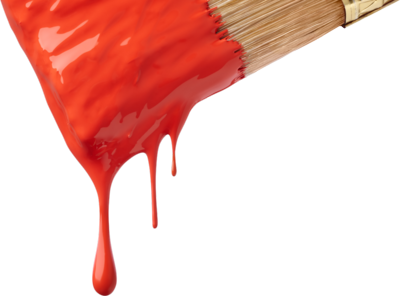In the past I have been the biggest idiot...or just lazy bones...about cleaning my paint brushes. I ruined several by not cleaning them correctly. Ultimately, I either had to buy another one or it made the next job I did much harder with a messed up brush.
How hard can this be? Well...it's not at all hard as long as you do it and I have a few tips that will help you to do it in such a way that your paint brush will seem as good as new when you do the next project.
If you are dealing with any water-based product or your typical latex paint you are going to have a pretty easy go of it. It cleans up pretty nicely with soap and water. Seems idiot proof (and it is) but there are a couple of things to keep in mind to make it easier on yourself.
Rule #1: Clean the brush IMMEDIATELY after you finish your project.
Don't leave the paint brush for a bit and then try and clean it. Clean it right away. Paint dries at different rates depending on a few factors, but the important thing is that you don't want the paint to dry and then be permanently crusted. Best way to avoid that is to wash it right away.
"Can't I just use paint thinner later?"
Yeah, probably, but I try to avoid it due to its toxicity and the extra work I would have to do later. Just do it right away and you won't even have to fight with it.
Rule #2: Follow the instructions for clean up on the product you are using.
These companies are really nice and try to make it easier on you. If they tell you to use something other than soap and water to clean your brush there is a reason. If you clean something oil-based with water you wont actually clean it correctly and you will run the risk of ruining your brush. They are giving you good advice, so my suggestion is to follow it, so don't be a lazy bones!
Water-Based
1. Rinse it out with water in the sink or with a hose.
2. Add a small amount of soap and work it in with your fingers, fan the brush out to help get the bristles clean in the center. You want to focus on more than just the outside part of the brush.
3. Rinse again and use your fingers to squeeze the water and paint out of the brush. Do that several times.
This whole process should take less than 5 minutes if you do it right away.
Oil-Based*
1. It will probably tell you to use paint thinner of mineral spirits, so put some in an old soup can, bucket or old coffee mug and let the brush sit in it for 15 minutes or so.
2. Rinse under water in the sink or with a hose.
3. Use an old towel or t-shirt to wipe the brush.
*Per contractor I know.
Rule #3: Get the excess water out of the brush for quicker drying time.
There are a couple of ways you can do this:
A) Use all the might in your arm to shake it out. Hold the handle and act like you are going to throw it on the ground as hard as possible, but don't actually throw it. The water will fly off the brush. Do that several times.
B) Hit it back and forth against a dry tree, brick, piece of wood, etc.
Either way you will get the water out and it dries pretty quickly. This is especially helpful for avoiding a large water puddle underneath the brush or if you have to use it for a different project soon after.
Go forth and have clean, usable brushes!


No comments:
Post a Comment